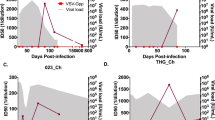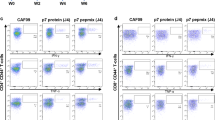Abstract
Hepatitis C virus (HCV) is endemic in many countries due to its high propensity for establishing persistence1. The presence of HCV-specific T cells in subjects repeatedly exposed to HCV who test negative for HCV RNA and antibodies and who do not have any history of HCV infection has been interpreted as T cell–mediated protection2,3,4,5. Here, we show in nonhuman primates that repeated exposure to human plasma with trace amounts of HCV induced HCV-specific T cells without seroconversion and systemic viremia but did not protect upon subsequent HCV challenge. Rather, HCV-specific recall and de novo T cell responses, as well as intrahepatic T cell recruitment and interferon-γ (IFN-γ) production, were suppressed upon HCV challenge, concomitant with quantitative and qualitative changes in regulatory T cells (Treg cells) that occurred after subinfectious HCV exposure and increased after HCV challenge. In vitro Treg cell depletion restored HCV-specific T cell responses. Thus, T cells primed by trace amounts of HCV do not generate effective recall responses upon subsequent HCV infection. Subinfectious HCV exposure predisposes to Treg cell expansion, which suppresses effector T cells during subsequent infection. Strategies to reverse this exposure-induced immune suppression should be examined to aid in the development of T cell−based vaccines against HCV and other endemic pathogens.
This is a preview of subscription content, access via your institution
Access options
Subscribe to this journal
Receive 12 print issues and online access
$209.00 per year
only $17.42 per issue
Buy this article
- Purchase on Springer Link
- Instant access to full article PDF
Prices may be subject to local taxes which are calculated during checkout




Similar content being viewed by others
References
Rehermann, B. Hepatitis C virus versus innate and adaptive immune responses: a tale of coevolution and coexistence. J. Clin. Invest. 119, 1745–1754 (2009).
Mizukoshi, E. et al. Hepatitis C virus (HCV)-specific immune responses of long-term injection drug users frequently exposed to HCV. J. Infect. Dis. 198, 203–212 (2008).
Freeman, A.J. et al. Prevalence of production of virus-specific interferon-γ among seronegative hepatitis C-resistant subjects reporting injection drug use. J. Infect. Dis. 190, 1093–1097 (2004).
Thurairajah, P.H. et al. Hepatitis C virus (HCV)-specific T cell responses in injection drug users with apparent resistance to HCV infection. J. Infect. Dis. 198, 1749–1755 (2008).
Zeremski, M. et al. Hepatitis C virus–specific T-cell immune responses in seronegative injection drug users. J. Viral Hepat. 16, 10–20 (2009).
Lechner, F. et al. Analysis of successful immune responses in persons infected with hepatitis C virus. J. Exp. Med. 191, 1499–1512 (2000).
Thimme, R. et al. Viral and immunological determinants of hepatitis C virus clearance, persistence, and disease. Proc. Natl. Acad. Sci. USA 99, 15661–15668 (2002).
Shoukry, N.H. et al. Memory CD8+ T cells are required for protection from persistent hepatitis C virus infection. J. Exp. Med. 197, 1645–1655 (2003).
Grakoui, A. et al. HCV persistence and immune evasion in the absence of memory T cell help. Science 302, 659–662 (2003).
Al-Sherbiny, M. et al. Exposure to hepatitis C virus induces cellular immune responses without detectable viremia or seroconversion. Am. J. Trop. Med. Hyg. 73, 44–49 (2005).
Scognamiglio, P. et al. Presence of effector CD8+ T cells in hepatitis C virus–exposed healthy seronegative donors. J. Immunol. 162, 6681–6689 (1999).
Veerapu, N.S., Raghuraman, S., Liang, T.J., Heller, T. & Rehermann, B. Sporadic reappearance of minute amounts of hepatitis C virus RNA after successful therapy stimulates cellular immune responses. Gastroenterology 140, 676–685 (2011).
Bassett, S.E. et al. Protective immune response to hepatitis C virus in chimpanzees rechallenged following clearance of primary infection. Hepatology 33, 1479–1487 (2001).
Major, M.E. et al. Previously infected and recovered chimpanzees exhibit rapid responses that control hepatitis C virus replication upon rechallenge. J. Virol. 76, 6586–6595 (2002).
Nascimbeni, M. et al. Kinetics of CD4+ and CD8+ memory T-cell responses during hepatitis C virus rechallenge of previously recovered chimpanzees. J. Virol. 77, 4781–4793 (2003).
Lanford, R.E. et al. Cross-genotype immunity to hepatitis C virus. J. Virol. 78, 1575–1581 (2004).
Folgori, A. et al. A T-cell HCV vaccine eliciting effective immunity against heterologous virus challenge in chimpanzees. Nat. Med. 12, 190–197 (2006).
Sakaguchi, S., Yamaguchi, T., Nomura, T. & Ono, M. Regulatory T cells and immune tolerance. Cell 133, 775–787 (2008).
Deaglio, S. et al. Adenosine generation catalyzed by CD39 and CD73 expressed on regulatory T cells mediates immune suppression. J. Exp. Med. 204, 1257–1265 (2007).
Biancotto, A., Dagur, P.K., Fuchs, J.C., Langweiler, M. & McCoy, J.P. Jr. OMIP-004: in-depth characterization of human T regulatory cells. Cytometry A 81, 15–16 (2012).
Kryczek, I. et al. Cutting edge: induction of B7–H4 on APCs through IL-10: novel suppressive mode for regulatory T cells. J. Immunol. 177, 40–44 (2006).
Sica, G.L. et al. B7–H4, a molecule of the B7 family, negatively regulates T cell immunity. Immunity 18, 849–861 (2003).
Larché, M., Akdis, C.A. & Valenta, R. Immunological mechanisms of allergen-specific immunotherapy. Nat. Rev. Immunol. 6, 761–771 (2006).
Meiler, F. et al. In vivo switch to IL-10–secreting T regulatory cells in high dose allergen exposure. J. Exp. Med. 205, 2887–2898 (2008).
Gottschalk, R.A., Corse, E. & Allison, J.P. TCR ligand density and affinity determine peripheral induction of Foxp3 in vivo. J. Exp. Med. 207, 1701–1711 (2010).
Apostolou, I. & von Boehmer, H. In vivo instruction of suppressor commitment in naive T cells. J. Exp. Med. 199, 1401–1408 (2004).
Curtsinger, J.M. & Mescher, M.F. Inflammatory cytokines as a third signal for T cell activation. Curr. Opin. Immunol. 22, 333–340 (2010).
Ebinuma, H. et al. Identification and in vitro expansion of functional antigen-specific CD25+ FoxP3+ regulatory T cells in hepatitis C virus infection. J. Virol. 82, 5043–5053 (2008).
Li, S. et al. Analysis of FOXP3+ regulatory T cells that display apparent viral antigen specificity during chronic hepatitis C virus infection. PLoS Pathog. 5, e1000707 (2009).
Kalia, V. et al. Prolonged interleukin-2Rα expression on virus-specific CD8+ T cells favors terminal-effector differentiation in vivo. Immunity 32, 91–103 (2010).
de Göer de Herve, M.G., Jaafoura, S., Vallee, M. & Taoufik, Y. FoxP3+ regulatory CD4 T cells control the generation of functional CD8 memory. Nat. Commun. 3, 986 (2012).
Takaki, A. et al. Cellular immune responses persist and humoral responses decrease two decades after recovery from a single-source outbreak of hepatitis C. Nat. Med. 6, 578–582 (2000).
Heller, T. et al. Occupational exposure to hepatitis C virus: early T-cell responses in the absence of seroconversion in a longitudinal cohort study. J. Infect. Dis. 208, 1020–1025 (2013).
Osburn, W.O. et al. Spontaneous control of primary hepatitis C virus infection and immunity against persistent reinfection. Gastroenterology 138, 315–324 (2010).
Mehta, S.H. et al. Protection against persistence of hepatitis C. Lancet 359, 1478–1483 (2002).
Finney, O.C., Nwakanma, D., Conway, D.J., Walther, M. & Riley, E.M. Homeostatic regulation of T effector to Treg ratios in an area of seasonal malaria transmission. Eur. J. Immunol. 39, 1288–1300 (2009).
Surls, J., Nazarov-Stoica, C., Kehl, M., Casares, S. & Brumeanu, T.D. Differential effect of CD4+Foxp3+ T-regulatory cells on the B and T helper cell responses to influenza virus vaccination. Vaccine 28, 7319–7330 (2010).
Black, G.F. et al. Patterns and implications of naturally acquired immune responses to environmental and tuberculous mycobacterial antigens in northern Malawi. J. Infect. Dis. 184, 322–329 (2001).
Buchbinder, S.P. et al. Efficacy assessment of a cell-mediated immunity HIV-1 vaccine (the Step Study): a double-blind, randomised, placebo-controlled, test-of-concept trial. Lancet 372, 1881–1893 (2008).
Shin, E.C. et al. The kinetics of hepatitis C virus–specific CD8 T-cell responses in the blood mirror those in the liver in acute hepatitis C virus infection. J. Virol. 82, 9782–9788 (2008).
Shin, E.C. et al. Delayed induction, not impaired recruitment, of specific CD8+ T cells causes the late onset of acute hepatitis C. Gastroenterology 141, 686–695 (2011).
Acknowledgements
We thank T.J. Rowell, J. Fontenot and the staff at New Iberia Research Center for the care of the chimpanzees and technical support and L. Holz (NIDDK) and W. Kastenmüller (NIAID) for discussion and reading of the manuscript. This work was supported by the intramural research program of the NIDDK.
Author information
Authors and Affiliations
Contributions
S.-H.P., N.S.V. and B.R. designed the study, analyzed the data and wrote the manuscript; S.-H.P., N.S.V. and E.-C.S. processed blood and liver biopsy samples; S.-H.P. and E.-C.S. characterized T cell responses; A.B. and J.P.M. characterized Treg cell subsets by flow cytometry; N.S.V. performed virological assays and some RT-PCR assays and A.F. and S.C. challenged three control chimpanzees and performed virological analyses. All authors discussed the results and commented on the manuscript.
Corresponding author
Ethics declarations
Competing interests
The authors declare no competing financial interests.
Supplementary information
Supplementary Text and Figures
Supplementary Figures 1–6, Supplementary Tables 1–2 and Supplementary Methods. (PDF 1668 kb)
Rights and permissions
About this article
Cite this article
Park, SH., Veerapu, N., Shin, EC. et al. Subinfectious hepatitis C virus exposures suppress T cell responses against subsequent acute infection. Nat Med 19, 1638–1642 (2013). https://doi.org/10.1038/nm.3408
Received:
Accepted:
Published:
Issue Date:
DOI: https://doi.org/10.1038/nm.3408
This article is cited by
-
SARS-CoV-2-specific T cell immunity in cases of COVID-19 and SARS, and uninfected controls
Nature (2020)
-
Cellular immune response to hepatitis-C-virus in subjects without viremia or seroconversion: is it important?
Infectious Agents and Cancer (2016)
-
Virus-specific antibodies allow viral replication in the marginal zone, thereby promoting CD8+ T-cell priming and viral control
Scientific Reports (2016)
-
Adaptive immunity in the liver
Cellular & Molecular Immunology (2016)
-
Host–virus interactions in hepatitis B and hepatitis C infection
Journal of Gastroenterology (2016)



